Marsha Balian is a self-taught mixed media artist living in the Bay Area. She incorporates found objects and invention in her work and frequently uses intense colors. Stories she hears from people find their way into her art. Her artwork has been shown throughout the Bay Area and in many parts of the country. It has also been seen in The Permanente Journal, American Art Collector, Studio Visit, Gathering Clouds, Scrubs Magazine, and West Marin Review. Balian is represented by the GearBox Gallery in Oakland, California. She formerly worked as a health care provider. See her work featured in The Woven Tale Press Vol. VIII #2.
Interview with Marsha Balian
By Jennifer Nelson, WTP Feature Writer
Nelson: Please describe your journey in becoming a self-taught artist, including how you invent your own techniques.
Balian: I have made art since early childhood, but somehow never considered studying it on a serious or formal level. By nature, I am an auto-didact, in great part because I don’t like being told what to do and I am also very resistant to following directions. This means that I often pay the price of doing things in ways that aren’t always efficient or might lead to work that fails profoundly.
But trial and error are part of the process as well. I do learn from my mistakes and thankfully they are less catastrophic than in the past. When work does succeed to my satisfaction, there can be a sense of victory and great pleasure.
Nelson: In your mixed media works, you use different materials, including lace, a collar from a doll dress, book pages, and assorted paper. Where do you find these materials and can you talk about how you incorporate them into your work?
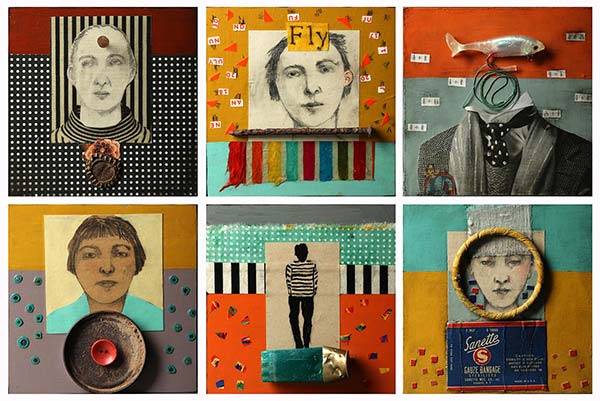
Balian: One of the really fun aspects of doing mixed media and collage is the opportunity it provides for play. There are no strict rules to follow and invention is encouraged by the marriage of uniting so many disparate materials.
Using found materials has led me to become a scavenger or as some have said, a hunter-gatherer. This can carry the risk of becoming a hoarder, not to mention that organizing piles of stuff (for me at least) can be really challenging. On the other hand, the world can be filled with treasures that someone else thinks are trash. Since I live in an urban setting, there is no end to the interesting stuff that can be found on the sidewalk, the curb, or even the street. I love the sense that I am giving some tossed object a new life.
Of course, used bookstores, rummage sales, thrift shops, occasionally an antique store and the cast-off objects of friends and neighbors along with leftover construction material from my husband are all great sources for me.
The process of working for me might begin with the object itself. In the individually titled six-piece work called “Minor Catastrophes,” my inspiration came from what I found during a walk in the Arizona desert. I came across such interesting things: a rusty nail, a used shotgun shell, the rusted lid of an old can. Somehow the nail made me think of the expression “I needed that like a hole in the head” (which is the title of the piece in the upper left-hand corner) and it took off from there.
In the piece “Conversation 1,” I played with some old wallpaper samples and pieces of lace I had accumulated. I drew the face on a page from an old book and repeated some of the shapes in paint that were suggested in the wallpaper sample. The lace reminded me of old waitress uniforms from my childhood. She’s looking off to the left and the companion piece “Conversation 2” has a woman looking off to the right as if they are talking to one another.
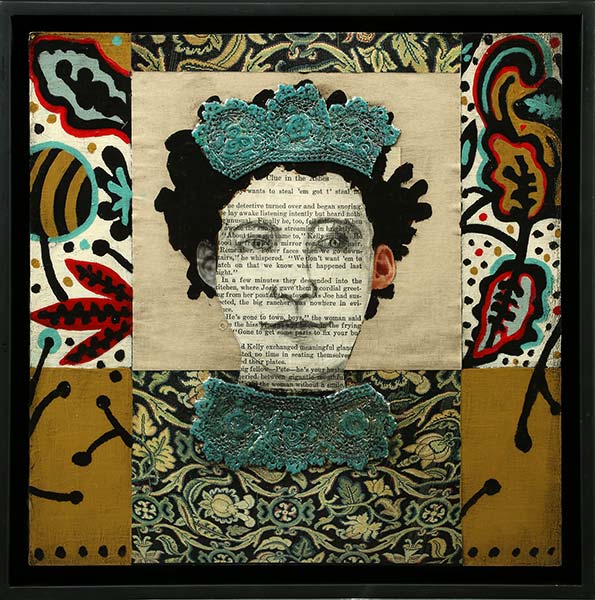
Nelson: What techniques do you use in the series Bad Grammar and what are the challenges and joys of creating these bright, abstract paintings?
Balian: For me, doing abstract work can be very relaxing. It is an intriguing problem-solving venture somewhat like doing a puzzle. I might start with a particular shape and color and somehow that suggests another shape and color. In a sense it begins a conversation within itself; you solve one problem and it creates another waiting to be solved.
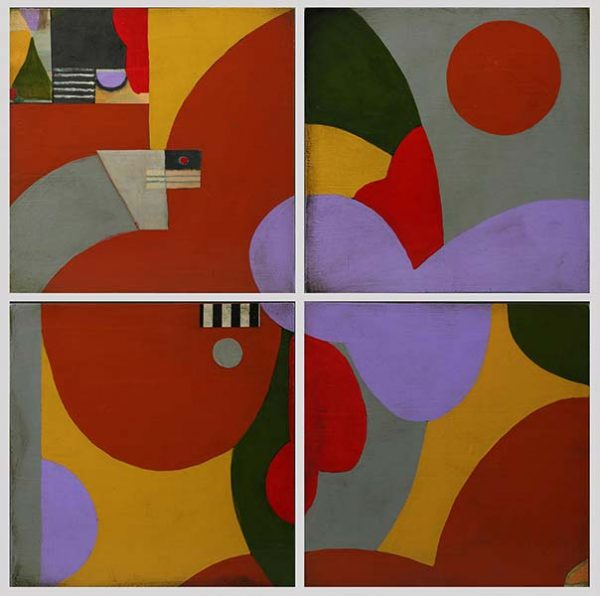
In “Split Infinitives” I wanted to play with curvilinear shapes. I started with the piece in the upper left corner and used some scraps of paper along with paint. But it needed company, so I started adding the other components that would work individually and as a whole.
In “Dangling Participles,” I also used pieces of paper which I cut into different shapes and then I painted larger swaths of color. Since I almost always work in series, each piece had to both stand alone and connect in some way to its neighbor. In a sense, it became a design (the overall appearance) within a design (each component).
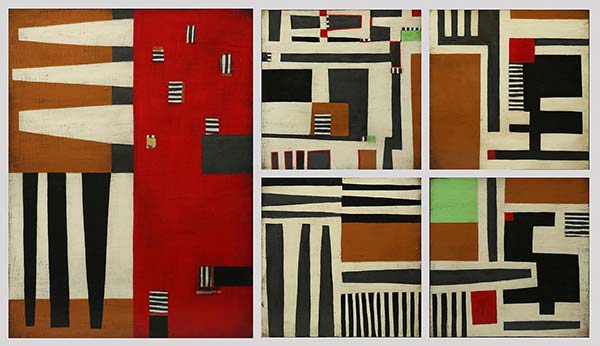
Nelson: In the About Face, you delicately draw faces in pencil then juxtapose them with found objects and acrylic paints. Can you talk about this series?
Balian: I love drawing faces perhaps because I have the bad habit of staring at people. There is nothing more fascinating to me. This series was intended to be quick, easy, and small (sizes ranging from 7” x 7” down to 4” x 4”). I also wanted to play with materials I had easily at hand.
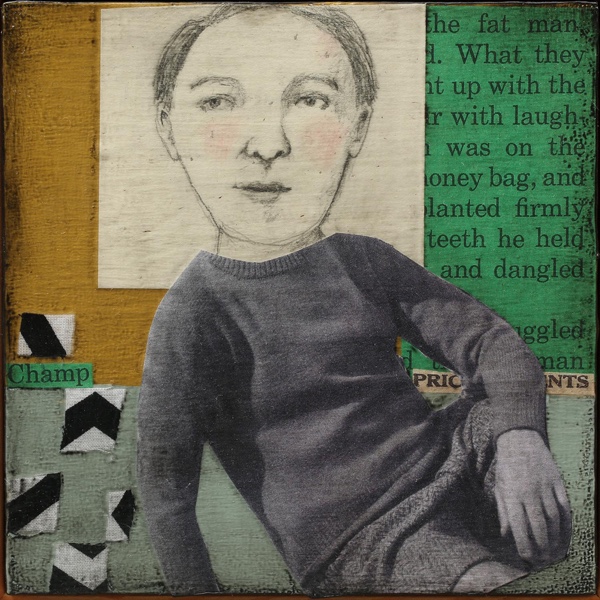
For instance, in the piece “Dangled,” the figure came from a knitting magazine from the 1930s and the green text on the right was from a children’s magazine from the 1940s. I drew the face with pencil and colored pencil and then later added chevron shapes from a piece of fabric.
The piece “Champion” made use of a page from a children’s book that someone named “Benny” had signed. The boy on the left sports knitted mittens also from the magazine referenced above. I don’t remember where the text in the lower right came from, but know that I chose it because the piece needed some red. The face is also drawn with pencil and colored pencil. Because no human face is symmetrical, I added an ear cut from a magazine photo.
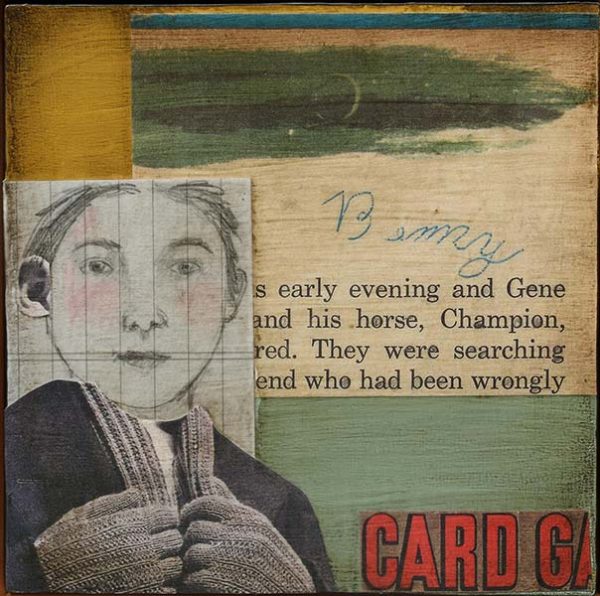
Nelson: From where do you gain inspiration for your artwork, and what compels you to produce? Has your previous job as a health care provider impacted your work?
Balian: For me, inspiration is fluid and sometimes elusive. Often it is the materials themselves that speak to me or suggest things to try. That said, I think that inspiration isn’t mandatory, but work is. Maintaining momentum is critical. This can mean if one is lucky, there is a level of engrossment that eliminates any sense of time, place, or other competing demands. That state of “flow” is in a way the drug that keeps many artists addicted to making work. When it happens (which isn’t all the time), it is exhilarating.
I was incredibly lucky to have had dual careers. I was able to work part-time as a nurse practitioner and the remainder of the time as an artist. Somehow, those two activities dovetailed beautifully. Because my work often has a narrative quality, it often came as a response to the many stories I heard from my patients. Because making art is very solitary, it was a lovely balance to be able to work so closely with people, and then entirely on my own in the studio.
Nelson: How do you see your artwork evolving in the future?
Balian: I don’t have a clear sense of how my work will evolve. I struggle to avoid getting stale, that is, reusing old ideas. There can be a tendency to create a brand as an artist which is okay, but somehow feels to me like cheating. I want my work to remain fresh. I look at art constantly and that stimulates ideas. I don’t keep a notebook, but perhaps one day I will. I do have a mental list of things I want to try, but having sufficient time is always a challenge. I think the goal in projecting towards the future, is to remain open to change, to letting things unfold without fear or judgement. I try to say to myself: “let’s see where this goes….”
Copyright 2020 Woven Tale Press LLC. All Rights Reserved.
